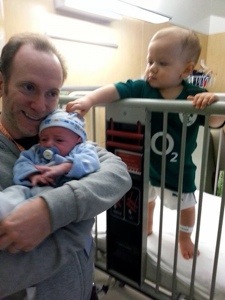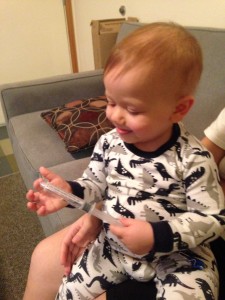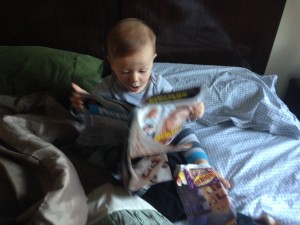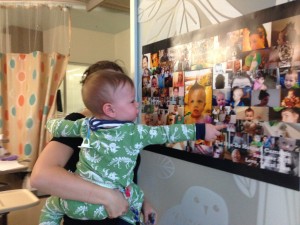
It’s a good thing that writing to you all is so therapeutic, because today was a doozy! It seems that the past few weeks have all been a bit of a downward slope, and lately we’ve been doing everything we can to can catch our fall. Since the poor T-cell chimerism results came back, we’ve been very stressed over the next steps and what the future brings. As if to distract us from worrying too much about the future, we have a new medical mystery to solve.
Although we spent the last few days worrying about Idan’s temperature, for the exception of the first hour we arrived to the hospital, it has been very low-grade. For that reason, we nearly lost our patience stewing in the hospital for so long with Idan having mostly normal (even if a bit high) temperatures. Every time his temperature reaches 37.4 degrees, they have to recheck the temperature every half hour, no matter the time of day or night, until it goes back down. 38.3 is considered a fever, and once he has a fever, we must stay in the hospital for at least 48 hours after the fever breaks (i.e., his temperature goes below 38.3). The past few days we have been hovering around the 37.4 mark, resulting in very frequent vitals around the clock, and, once a day, just when we think we’re in the clear, it reaches 38.4 and holds there for about half an hour before it drops back down, and we start the clock all over again. So this morning during rounds we discussed with the doctors the possibility of going home today, watching his temperature, and if it spiked, we would bring him back in. While we are all anxious to get Idan back to a normal routine and allow him to rest, however, the fact remains that we are no closer to determining the root cause of Idan’s temperature.
All tests have come back negative thus far, so they have ruled out most viruses and bacterial infections (or at least those capable of testing for). To complicate things, Idan needed a blood transfusion today (which, in and of itself, is par for course for post-transplant), and during the transfusion his temperature went up and he began to develop a rash all over his body. It is possible that he was having a reaction to the blood products, but those tests also came back negative. The rash seems to have subsided for the most part. A couple hours later, Idan was unable to keep down his food, resulting in a cleaning crew having to mop the entire floor. Now, it looks more like the low-grade fevers and rash and vomiting might be GvHD, but not all of his symptoms are consistent with that either.
With the aid of some anti-nausea and anti-itching meds, Idan is sleeping sweetly now. We are hoping against hope that all of this is an acute mild GvHD caused by the onset of donor T-cell engraftment (the cells that have eluded us thus far). But we are also worried that something else is brewing, and after our experience in April with Idan’s pneumonia, we are a bit traumatized by medical mysteries.
We hope to have more answers over the course of the next few days. In the meantime, we are very blessed to have the company of Akiva’s brother and sister-in-law who have traveled across the country, baby in tow, to introduce us and Idan to the newest and tiniest addition to the Zablocki family (seriously, Idan suddenly looks like a giant!). In addition, since arriving at the hospital, we’ve received so many sweet notes of encouragement and more ways to keep Idani happy and entertained while he’s couped up all day. On another wonderfully positive note, our donor has agreed to donate additional cells for Idan – on December 23rd, no less! We have tentatively scheduled the DLI for December 24th, knowing that the DLI may not be an option by then, but also hoping that it won’t be necessary if Idan’s T-cells engraft. It is such a testament to the character of Idan’s donor that he has dropped everything on only a week’s notice and only a couple days before one of the most celebrated holidays of the year to come to Idan’s rescue. We hope to one day meet this incredible man!
As always, we are uplifted by your prayers and encouragement, and funnel all of that positive energy into everything we do for Idan. Thank you and lots of love to you all.


